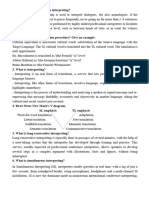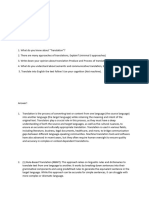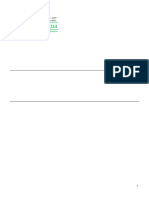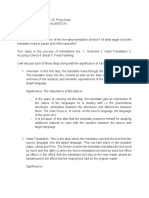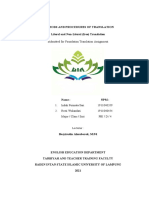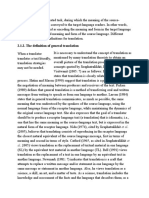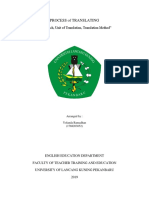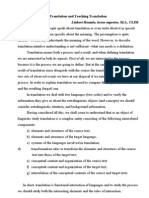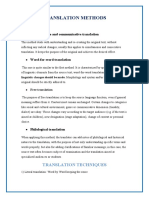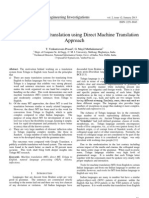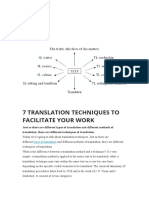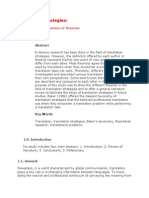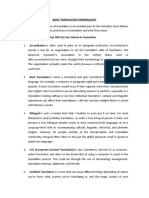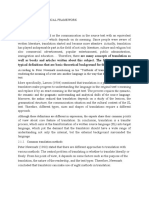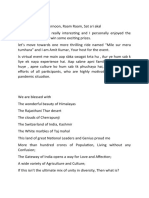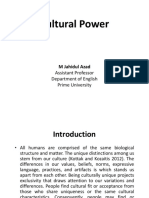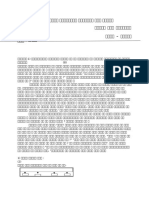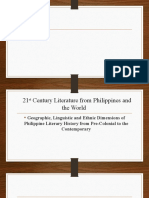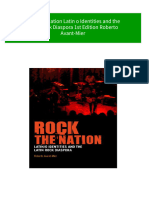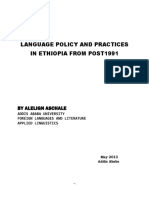Summary Translation
Summary Translation
Uploaded by
Lenta PandianganCopyright:
Available Formats
Summary Translation
Summary Translation
Uploaded by
Lenta PandianganOriginal Title
Copyright
Available Formats
Share this document
Did you find this document useful?
Is this content inappropriate?
Copyright:
Available Formats
Summary Translation
Summary Translation
Uploaded by
Lenta PandianganCopyright:
Available Formats
TRANSLATION PROCEDURES
Translation is a field of various procedures. translators can use various procedures with
different interests. There are definitions of the most important procedures used by translators,
such as:
1. Transliteration
This procedure refers to conversion foreign letters into the target language letter (TL). In
fact, this operation usually concerns the right one names that have no equivalent in the
target language text (TLT).
2. Borrowing
this procedure refers to a case where a word or an expression is taken from the source
language and used in the target language, but in a 'naturalized' form, that is, it is made
to conform to the rules of grammar or pronunciation of the target language.
3. Calque
in this procedure, the translator mimics in his translation structure or the mode of
expression of the source language.
4. Transposition
this procedure is a grammatical change occurs in translation from the source language
to the target language. Transposition consists of four types of grammatical changes,
such as:
concerns word's form and position
transposition is usually used when the target language does not have the equal
grammatical structure of the source language.
the one where literal translation is grammatically possible but may not accord with
the natural usage in the target language.
translator uses a grammatical structure as a way to replace a lexical gap.
5. Modulation
Based on expert’s definition, Gérard Hardin and Gynthia Picot (1990), this procedure is a
change in point of view that allows us to express the same phenomenon in a different
way.
modulation as a translation procedure occurs when there is a change in perspective
accompanied by a change in the lexical of the target language.
6. Reduction and expansion
in reduction procedures, translators are more likely to reduce the number elements that
make up the source language text. This procedure must respect the principle of
relevance, this means that translators must ensure that no important information is
dropped in the translation.
Expansion procedures refers to the case where the translator exceeds the number of
words of the source language text in translation.
7. Adaptation
this procedure is used as an effective way of dealing with culture-bound words and
expressions, metaphors and images in translation. That is, the translator is forced
rewrite the source language text according to the characteristics of the target language
text.
8. Additions, notes, and glosses
this procedure is used by translators to add information about culturally bound words /
expressions, or technical terms related to a particular domain. additional
Information can be written as glosses at the end of the book, with the help of numbers
reference.
translation procedures are different in characteristics and uses. Each procedure has its own
advantages that differ according to the texts under translation. translator may restrict himself
to one procedure, or exceed it to two, three, or even four procedures in the same translated
text, and this is what we refer to as couplets, triplets and quadruplets.
You might also like
- Translation Strategies Pragmatic ChestermanDocument13 pagesTranslation Strategies Pragmatic ChestermanLeo Liew100% (3)
- Translation Evaluation RubricDocument1 pageTranslation Evaluation RubricMichelle Mills Smith100% (9)
- Inductive Grammar Chart (Unit 1, Page 4) GRAMMAR. Verb Be: Singular Statements I ContractionsDocument2 pagesInductive Grammar Chart (Unit 1, Page 4) GRAMMAR. Verb Be: Singular Statements I ContractionsDANIEL ANDRES DIAZ VEGA ESTUDIANTENo ratings yet
- Culture Bumps LeppihalmeDocument4 pagesCulture Bumps LeppihalmeCarla Luján Di BiaseNo ratings yet
- The 3-Month EnglishDocument24 pagesThe 3-Month English陳大慶100% (1)
- OnographDocument34 pagesOnographdawodaimaq123No ratings yet
- A Definition of Translation TechniquesDocument7 pagesA Definition of Translation TechniquesMarkusMakuAldo100% (2)
- Basic Concepts of Translation Theory: Translation According To M. LarsonDocument7 pagesBasic Concepts of Translation Theory: Translation According To M. LarsonRuth DebyNo ratings yet
- TranslationDocument7 pagesTranslationMuetya Permata DaraNo ratings yet
- TranslationDocument14 pagesTranslationLakas TamaNo ratings yet
- Week 1: Some Issues in Translation Practice & Interpreting PracticeDocument31 pagesWeek 1: Some Issues in Translation Practice & Interpreting PracticeVân AnhNo ratings yet
- Final Revision - Theory of TranslationDocument4 pagesFinal Revision - Theory of Translationgaga1952002No ratings yet
- Translation Thesis ReportDocument7 pagesTranslation Thesis ReportRafika FairuzNo ratings yet
- Pragmatics in TranslationDocument6 pagesPragmatics in TranslationAdriana MantaluţaNo ratings yet
- Mid Tes by Sri Ainun LussyDocument3 pagesMid Tes by Sri Ainun LussyhehanussahaddarNo ratings yet
- Chapter IiDocument23 pagesChapter IiAlievia NANo ratings yet
- Chapter 2 LiteratureDocument6 pagesChapter 2 LiteratureemiliaNo ratings yet
- Translation Strategies, by Dr. Shadia Y. Banjar - PPT (Compatibility Mode)Document15 pagesTranslation Strategies, by Dr. Shadia Y. Banjar - PPT (Compatibility Mode)Dr. Shadia100% (2)
- Translation Lecture 1Document3 pagesTranslation Lecture 1Linsley MalinaoNo ratings yet
- Translation Exam GuideDocument6 pagesTranslation Exam GuideOrlando RubioNo ratings yet
- Types of TranslationDocument4 pagesTypes of TranslationTatiana SirbuNo ratings yet
- The Application of Translation Strategies To Cope With Equivalence Problems in Translating TextsDocument7 pagesThe Application of Translation Strategies To Cope With Equivalence Problems in Translating TextsasdrjkkshvnzsbvNo ratings yet
- Addition and Deletion of Information in The Translation of Negeri 5 Menara by A. FuadiDocument6 pagesAddition and Deletion of Information in The Translation of Negeri 5 Menara by A. FuadiditahermaNo ratings yet
- 10 - Chapter 3 PDFDocument22 pages10 - Chapter 3 PDF桂翔No ratings yet
- TsaDocument3 pagesTsaMr. IMRANNo ratings yet
- Lecture 4 - 033010Document3 pagesLecture 4 - 033010leilalilyana950No ratings yet
- Lesson 11Document3 pagesLesson 11azumichui89No ratings yet
- Summary Translation TheoryDocument4 pagesSummary Translation TheoryRealarmedNo ratings yet
- Methods and Procedures of Translation Literal and Non-Literal (Free) TranslationDocument12 pagesMethods and Procedures of Translation Literal and Non-Literal (Free) Translationnely nurcahyaniNo ratings yet
- Translation Theory Assignment: Tuetech UniversityDocument7 pagesTranslation Theory Assignment: Tuetech UniversityKb NguyenNo ratings yet
- Translation Is A Complicated TaskDocument15 pagesTranslation Is A Complicated TaskhmddaikhNo ratings yet
- Translation Strategies 1Document16 pagesTranslation Strategies 1Nestor RiveroNo ratings yet
- Translation Process TheoriesDocument2 pagesTranslation Process TheoriesFadlilah DilsNo ratings yet
- Coursework byDocument30 pagesCoursework byakbarsharipov001No ratings yet
- Process of TranslationDocument8 pagesProcess of TranslationYolanda RamadhanNo ratings yet
- Week 09 PPT DTRA340 Translation (Updated)Document22 pagesWeek 09 PPT DTRA340 Translation (Updated)vjrnrjfdnsNo ratings yet
- Loss Dan Gain Pada Terjemahan Buku Hukum The Conce PDFDocument16 pagesLoss Dan Gain Pada Terjemahan Buku Hukum The Conce PDFDyah Roro TeamNo ratings yet
- Law Karya H. L. A Hart Ke Dalam Versi Bahasa Indonesia "Konsep Hukum" Hanifa Pascarina, M. R. Nababan, Riyadi SantosaDocument16 pagesLaw Karya H. L. A Hart Ke Dalam Versi Bahasa Indonesia "Konsep Hukum" Hanifa Pascarina, M. R. Nababan, Riyadi SantosaNur Hasyami BerutuNo ratings yet
- Translation and Teaching Translation. 2008 - копияDocument10 pagesTranslation and Teaching Translation. 2008 - копияelvinaelf100% (1)
- Translation Techniques IvDocument3 pagesTranslation Techniques IvPatricia GonzalezNo ratings yet
- Discovering Machine Translation Strategies Beyond Word-for-Word Translation: A Laboratory AssignmentDocument4 pagesDiscovering Machine Translation Strategies Beyond Word-for-Word Translation: A Laboratory AssignmentNunuk StokuneztyNo ratings yet
- Translation Models: Prepared by Yurii Vakulchyk Group MA-51Document9 pagesTranslation Models: Prepared by Yurii Vakulchyk Group MA-51Yurii VakulchikNo ratings yet
- Human Translation ProcessDocument12 pagesHuman Translation ProcessEnikőNo ratings yet
- Direct Translation TechniquesDocument12 pagesDirect Translation TechniquesDaniela Michelle Ojeda ValdiviaNo ratings yet
- Methods and TechniquesDocument4 pagesMethods and TechniquesEdwin ValdesNo ratings yet
- Telugu To English Translation Using Direct Machine Translation ApproachDocument8 pagesTelugu To English Translation Using Direct Machine Translation ApproachInternational Journal of Science and Engineering InvestigationsNo ratings yet
- Translation-Related Linguistic Studies: - Part TwoDocument11 pagesTranslation-Related Linguistic Studies: - Part TwohazarNo ratings yet
- 7 Translation Techniques To Facilitate Your WorkDocument3 pages7 Translation Techniques To Facilitate Your WorkEngy ObadNo ratings yet
- Translation Strategies - A Review and Comparison of Theories - Featured ArticleDocument17 pagesTranslation Strategies - A Review and Comparison of Theories - Featured ArticleNathan BarnesNo ratings yet
- 1.2 Translation TheoryDocument3 pages1.2 Translation TheoryAdriana VirjogheNo ratings yet
- Translation StrategiesDocument15 pagesTranslation StrategiesLitera CircleNo ratings yet
- Basic Translation TerminologyDocument7 pagesBasic Translation TerminologyHeidy BarrientosNo ratings yet
- FrameworkDocument2 pagesFrameworkVienoi ISUNo ratings yet
- Interlingual, Intralingual Ans Intersemiotic Tran...Document14 pagesInterlingual, Intralingual Ans Intersemiotic Tran...charlot besasNo ratings yet
- Modul Basic TranslationDocument69 pagesModul Basic TranslationawanNo ratings yet
- Translation Errors: A Taxonomic Approach and Their Contribution To Translator TrainingDocument6 pagesTranslation Errors: A Taxonomic Approach and Their Contribution To Translator TrainingIJELS Research JournalNo ratings yet
- Different Angles of Translation Level 300Document5 pagesDifferent Angles of Translation Level 300jp716495No ratings yet
- ChatGPT for Linguists: Revolutionize Language Research and Analysis with AI-Driven Insights (2024 Guide)From EverandChatGPT for Linguists: Revolutionize Language Research and Analysis with AI-Driven Insights (2024 Guide)No ratings yet
- The Global English Style Guide: Writing Clear, Translatable Documentation for a Global MarketFrom EverandThe Global English Style Guide: Writing Clear, Translatable Documentation for a Global MarketNo ratings yet
- Gale Researcher Guide for: Taking Responsibility for the Work of Other WritersFrom EverandGale Researcher Guide for: Taking Responsibility for the Work of Other WritersNo ratings yet
- Martin Simon The Old ManDocument60 pagesMartin Simon The Old ManAngel SánchezNo ratings yet
- History and Political Science EngDocument29 pagesHistory and Political Science EngShaikh AltamashNo ratings yet
- Leger Nilai Rapor Kelas XI TKR 3Document4 pagesLeger Nilai Rapor Kelas XI TKR 3Kurikulum Angkasa 1No ratings yet
- English 12 NEW - Unit 5. Cutural IdentityDocument6 pagesEnglish 12 NEW - Unit 5. Cutural IdentitylephuongvnuNo ratings yet
- Lesson Plan About GrafittiDocument2 pagesLesson Plan About GrafittiAna Losada PérezNo ratings yet
- Méthode Commentaire CivilisationDocument3 pagesMéthode Commentaire Civilisationfrederic.ouhayoun775No ratings yet
- Mile Sur Mera Tumhara1Document6 pagesMile Sur Mera Tumhara1Komal PriyaNo ratings yet
- Cultural PowerDocument29 pagesCultural PowerJannatul Nayma MouNo ratings yet
- May 2013 Subject ReportDocument11 pagesMay 2013 Subject ReportezzNo ratings yet
- Fan Culture DissertationDocument6 pagesFan Culture DissertationThesisPapersForSaleUK50% (2)
- Philippine Literature During The Precolonial Period-FinalDocument42 pagesPhilippine Literature During The Precolonial Period-FinalKassandra KayNo ratings yet
- What Is The Difference Between English Literature and American Literature00Document3 pagesWhat Is The Difference Between English Literature and American Literature00AssagNo ratings yet
- Rubrik Penilaian Teks BeritaDocument29 pagesRubrik Penilaian Teks Beritajeonwonwoo0112No ratings yet
- Specific Guidelines in Test Item FormulationDocument30 pagesSpecific Guidelines in Test Item FormulationGrace Ann AquinoNo ratings yet
- Admission CardDocument1 pageAdmission Card705 Akanksha OjhaNo ratings yet
- Anh Chinh TH C 2023Document6 pagesAnh Chinh TH C 2023Châu NguyễnNo ratings yet
- 7th STD Hindi 1st SemDocument5 pages7th STD Hindi 1st SemDharmendra MishraNo ratings yet
- 1 Geographic Linguistic and Ethnic Dimensions OfPhil Literary History...Document29 pages1 Geographic Linguistic and Ethnic Dimensions OfPhil Literary History...Xander LeeNo ratings yet
- (Mallari) Difference Between English and Japanese LanguageDocument5 pages(Mallari) Difference Between English and Japanese LanguageJohn Kyle Capispisan TansiongcoNo ratings yet
- Speaking Rubric - ActivitiesDocument3 pagesSpeaking Rubric - ActivitiesdeboraNo ratings yet
- Lesson ShapesDocument6 pagesLesson ShapesAmaniNo ratings yet
- A Case Study of Netflix's Entry Into KoreaDocument13 pagesA Case Study of Netflix's Entry Into KoreabrianNo ratings yet
- PR An Phis Fhliuch (Slip Jig) On The SessionDocument40 pagesPR An Phis Fhliuch (Slip Jig) On The SessionHarry TaylorNo ratings yet
- Face2face Cambridge English Course PDFDocument2 pagesFace2face Cambridge English Course PDFHarlow0% (1)
- (FREE PDF Sample) Rock The Nation Latin o Identities and The Latin Rock Diaspora 1st Edition Roberto Avant-Mier EbooksDocument84 pages(FREE PDF Sample) Rock The Nation Latin o Identities and The Latin Rock Diaspora 1st Edition Roberto Avant-Mier Ebooksxeethmsric100% (4)
- Language Policy and Practices in Ethiopia From Post1991: by Alelign AschaleDocument13 pagesLanguage Policy and Practices in Ethiopia From Post1991: by Alelign AschaleMissael AyalewNo ratings yet
- As 25Document324 pagesAs 25JasonNo ratings yet
- SO3 B1 SB ContentsDocument2 pagesSO3 B1 SB ContentsRubyNo ratings yet











